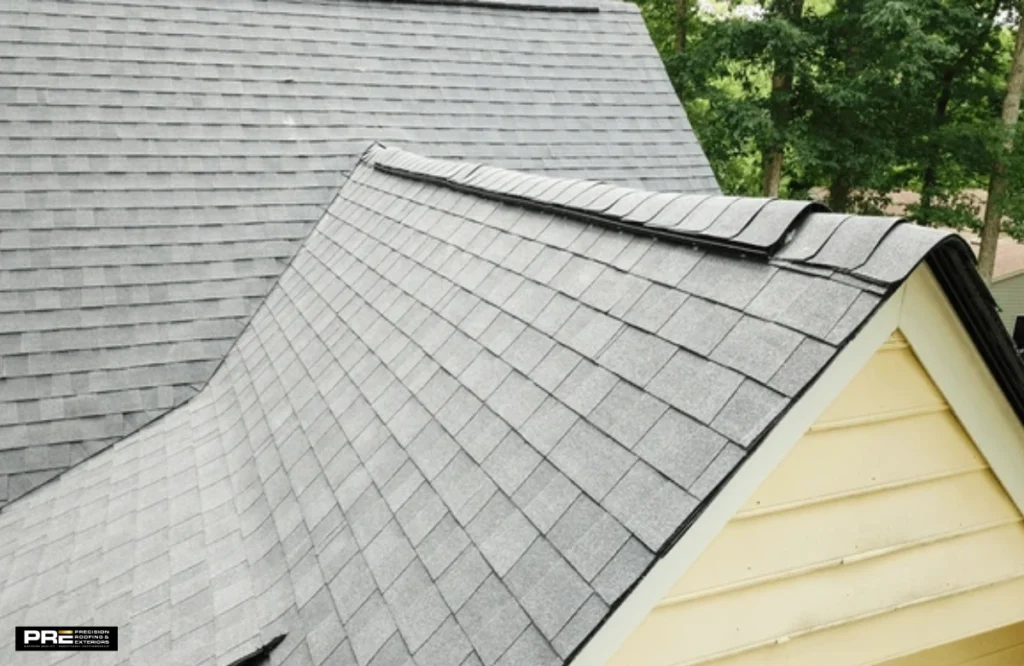Your roof does more than protect your home. It also needs to breathe. Without proper ventilation, heat and moisture can build up in your attic, leading to mold, warped wood, and higher energy bills.
A roof ridge vent solves that problem. Installed along the roof’s peak, it allows hot, humid air to escape while cooler air flows in through soffit vents. This steady airflow keeps your attic balanced, your roof materials in better shape, and your home more energy-efficient. It’s a simple feature that quietly makes your roof last longer and your house more comfortable year-round.
Understanding a Roof Ridge Vent and How It Works
A roof ridge vent is a continuous strip installed along the very peak of a roof. It’s designed to let hot, stale air out of your attic, like a pressure release valve for your home.
Without one, heat and humidity can build up fast. That’s when trouble starts: warped shingles, mold, or sky-high cooling bills.
How It Works
A ridge vent is simple but genius. It uses basic airflow physics to keep your attic from overheating or collecting moisture. Here’s how it plays out:
- Hot air rises: When your attic heats up, whether from the sun baking your roof or warm indoor air drifting upward, that heat naturally climbs to the top.
- The ridge vent gives it an exit: Installed right along the roof’s peak, it lets that trapped humid air escape instead of sitting there cooking your insulation and shingles.
- Cool air moves in from below: Fresh air enters through soffit or eave vents near the roof’s edge, creating a steady flow of cool air in and warm air out.
- That balance is everything: Without proper intake vents below, the system can’t “breathe.” It’s like trying to exhale without inhaling. Nothing moves.
The result? A cooler, drier attic that protects your shingles, prevents mold, and helps your home feel way more comfortable (and energy-efficient).
Types of Roof Ridge Vents
Not all ridge vents are built the same. Depending on your roof design, climate, and aesthetic goals, there are a few main styles to consider. Here’s a quick breakdown:
| Type of Ridge Vent | Description | Typical Use |
| Standard Ridge Vent (Shingle-Over) | A continuous vent installed beneath ridge cap shingles; it’s nearly invisible once installed. | Most common option for asphalt shingle roofs; blends in beautifully. |
| Metal Ridge Vent | Made of aluminum or steel for durability, especially suited for metal roofing or high-wind regions | Perfect for metal roofs or areas with high winds. |
| Ridge Vent with External Baffle or Cap | Includes a protective baffle to block rain, snow, and debris while improving airflow. | Great for homes in wet or snowy climates. |
| Hip-Ridge Vent System | Extends along both ridges and hips for extra ventilation. | Ideal for complex roof designs with multiple peaks. |
Benefits of Roof Ridge Vents
Here are some of the benefits you should know.
Prevents Ice Dams in Winter
Here’s one thing a lot of people forget: ridge vents help in winter too. When warm air can escape evenly through the top of your roof, snow doesn’t melt unevenly and refreeze along the edges. That stops those nasty ice dams that clog gutters and cause leaks when they melt.
Improves Indoor Comfort Year-Round
Good attic ventilation keeps your house feeling steady. It’s not crazy hot upstairs and chilly downstairs. The airflow from ridge vents naturally balances temperatures. You’ll notice the difference most on those muggy summer nights when your home just feels lighter and airier somehow.
Reduces Strain on Your HVAC System
If your attic’s roasting all day, your AC works overtime trying to cool the living space below. That constant load wears it down faster. Ridge vents give your system a break by letting trapped heat out before it spreads. Less work, less stress, fewer repair bills. Simple math.
Adds to Your Roof’s Appearance
Ridge vents look clean. They sit flat along the roof’s peak, hidden beneath ridge caps, so you get proper ventilation without bulky vents sticking out everywhere. The design’s subtle enough that most people never notice it’s even there, which is kind of the point.
Protects Your Insulation
When hot air and moisture linger, they mess with your insulation, making it damp, heavy, and less effective. Ridge vents prevent that by keeping the air dry and moving. Good insulation only works if it stays dry, and this setup helps ensure that it does.
Adds Long-Term Value to Your Home
Buyers might not see a ridge vent right away, but home inspectors do. Proper ventilation is a sign of a well-built, well-maintained roof. It’s one of those small details that quietly boost your home’s value because it shows the roof is built to last.
Conclusion
A roof ridge vent sits at the top of your roof, letting your house breathe. It releases hot air, keeps moisture out, and helps your home stay cool and calm. You’ll barely notice it’s there but your roof will thank you for it every single day.
Feel free to get in touch with trusted roofing contractor like Precision Roofing for more information.

